Aluminium Meets Plastics Challenge
Page 86
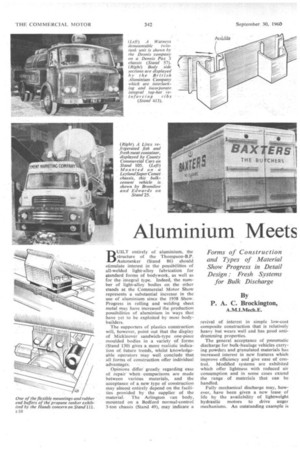
Page 87
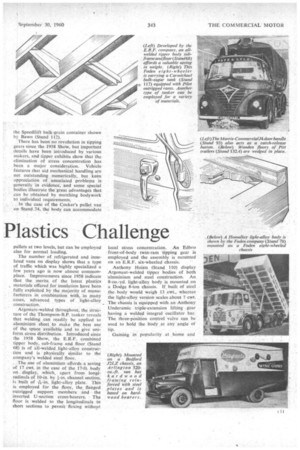
Page 88
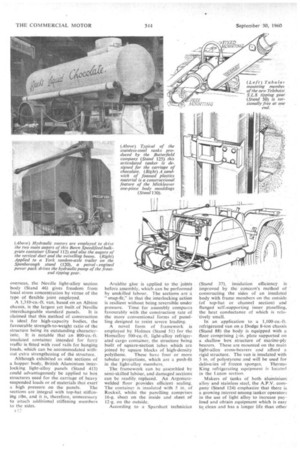
Page 89
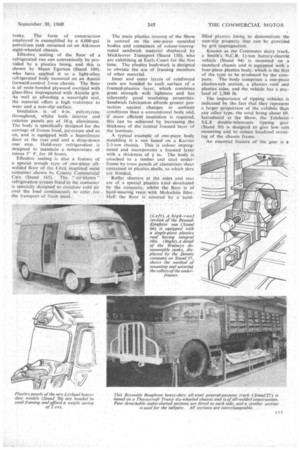
Page 90
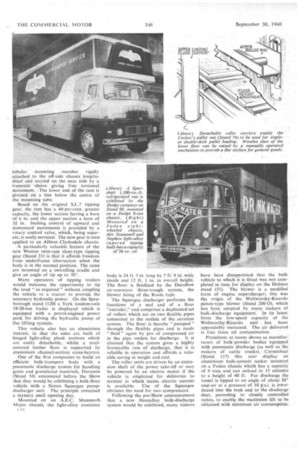
Page 91

If you've noticed an error in this article please click here to report it so we can fix it.
Forms of Construction and Types of Material Show Progress in Detail Design. Fresh Systems for Bulk Discharge By P. A. C. Brockington,
A.M.I.Mech.E. BUILT entirely of aluminium, the structure of the Thompson-B.?. Autotanker (Stand 86) should stimulate interest in the possibilities of all-welded light-alloy fabrication for standard forms of bodywork, as well as for the,integral type. Indeed, the number of light-alloy bodies on the other stands at the Commercial Motor Show represents a substantial increase in the use of aluminium since the 1958 Show. Progress in rolling and welding sheet metal may have increased the production possibilities of aluminium in -ways that have yet to be exploited by most bodybuilders.
The supporters of plastics construction will, however, point out that the display of Mickleover sandwich-type one-piece moulded bodies in a variety of forms (Stand 130) gives a more realistic indication of. future trends, whilst knowledgeable operators may well conclude that all forms of construction offer individual advantages:
'Opinions differ greatly regarding ease of repair when comparisons are made between various materials, and the acceptance. of a new type of construction may almost entirely depend on the facilities provided by the supplier of the material. The Arlington van body, mounted on a Bedford normal-control 3-ton chassis (Stand 49), may indicate a
revival of interest in simple low-cost composite construction that is relatively heavy but wears well and has good antidrumming properties.
The general acceptance of pneumatic discharge for bulk-haulage vehicles carrying powders and granulated materials has increased interest in new features which improve efficiency and give ease of control. Modified systems are exhibited which offer lightness with reduced air consumption and in some cases extend the range of materials that can be handled.
Fully mechanical discharge may, however, have been given a new lease of life by the availability of lightweight hydraulic motors to drive auger mechanisms. An outstanding example is the Speedilift bulk-grain container shown by Bawn (Stand 112).
There has been no revolution in tipping gears since the 1958 Show, but important details have been introduced by various makers, and tipper exhibits show that the elimination of stress concentration has been a major consideration. Vehicle features that aid mechaniCal handling are not outstanding numerically, but keen appreciation of associated problems is generally in evidence, and some special bodies illustrate the great advantages that can be obtained by matching bodywork to individual requirements.
. In the case of the Cocker's pallet van on Stand,74, the body can accommodate
pallets at two levels, but can be employed also for normal loading.
The number of refrigerated and insulated vans on display shows that a type of traffic which was highly specialized a few years ago is now almost commonplace. Improvements since 1958 indicate that the merits of the latest plastics , materials offered for insulation have been fully exploited by the majority of manufacturers in, combination With, in many cases, advanced types of light-alloy construction.'
Argonarc-welded throughout, the strtic .
ture of the Thompson-H.P. tanker reveals that welding can readily be applied to .aluminium sheet to make the best use of the space available and to give uniform stress distribution. Introduced since the 1958 Show, the E.R.F. combined tipper body, sub-frame and floor (Stand 68) is of 'all-welded light-alloy construction and is physically similar to the company's welded steel floor. • • The .use of aluminium affords a saying . of 17 cwt. in the case of the 17-ft body on display, which, apart from, longitudinals of 10-in. by 1-in, channel section; is built of light-alloy plate. This is employed for the floor, the, flanged outrigged support members and the inverted U-section cross-bearers. The floor is welded .to the longitudinals in short sections to permit flexing without local stress concentration. An Edbro front-of-body twin-ram tipping gear is employed and the assembly is mounted on an E.R.F. six-wheeled chassis.
Anthony Hoists (Stand 110) display Argonaut-welded tipper bodies of both aluminium and steel construction. An 8-cu.-yd. light-alloy body is mounted on a Dodge 8-ton chassis. If builtof steel the body would weigh 13 cwt., whereas the light-alloy version scales about 7 cwt. The chassis is equipped with an Anthony Underamic triple-extension lifting •gear having a welded integral oscillator bar. The three-position control valve can be used to hold the body at any angle of tip.
Gaining in popularity at home and overseas, the Neville light-alloy section body (Stand 46) gives freedom from local stress concentration by virtue of the type of flexible joint employed.
A 1,310-cu.-ft. van, based on an Albion chassis, is the largest yet built of Neville interchangeable standard panels. It is claimed that this method of construction is ideal for high-capacity bodies, the favourable strength-to-weight ratio of the structure being its outstanding characteristic. It is notable that an 800-cu.-ft. insulated container intended for ferry traffic is fitted with roof rails for hanging loads. which can be accommodated without extra strengthening of the structure.
Although exhibited as side sections of a hopper body, 13ritish Aluminium interlocking light-alloy panels (Stand 413) could advantageously be applied to box structures used for the carriage of heavy suspended loads or of materials that exert a high pressure on the panels. The sections are integral with top-hat stiffening ribs, and it is, therefore, unnecessary to attach additional stiffening members to the sides.
Araldite glue is applied to the joints before assembly, which can be performedby unskilled labour. The sections are a "snap-fit," in that the. interlocking-action is resilient without being reversible. under pressure. Time for assembly compares favourably with the construction rate of the more conventional forms of panelling designed to resist severe loading.
A novel form of framework is employed by Holmes (Stand 51) for the 1-romalloy 500-cu.-ft. light-alloy 'refrigerated cargo container, the structure being built of square-section tubes which are joined by square blocks of high-density polythene. These have four or more tubular projections, which are a push-fit in the light-alloy members.
The framework can be assembled by labOur, and damaged sections can be readily. replaced. An Argonarcwelded floor provides efficientsealing. The container is insulated with 5 in. of Rocksil, whilst the panelling comprises 16-g. sheet on the inside and sheet of 12-g. on the outside.
According to a Sparshatt technician (Stand 37), insulation efficiency is improved by the concern's method of constructing the Sides of an insulated body with frame members on the outside (of top-hat or channel section) and flanged self-supporting inner panelling, the heat conductance of which is relatively small.
In an application to a 1,100-cu-ft. refrigerated van on a Dodge 8-ton chassis (Stand 88) the body is equipped with a floor comprising 1-in, plate supported on a shallow box structure of marine-ply bearers. These are mounted on the main Tight-alloy cross-bearers and afford a rigid structure. The van is insulated with 5 in of polystyrene and will be used for deliveries of frozen sponges. Thermo King refrigerating equipment is located in the Luton section.
Makers of tanks of both aluminium alloy and stainless steel, the A.P.V. company (Stand 124) emphasize that there is a growing interest among tanker operators in the use of light alloy to increase payload and obtain equipment which is easy to clean and has a longer life than other tanks. The form of construction employed is exemplified by a 4,000-gal. petroleum tank mounted on an Atkinson eight-wheeled chassis.
Effective sealing of the floor of a refrigerated van can conveniently be provided by a plastics lining, and this is shown by Mann Egerton (Stand 109), who have applied it to a light-alloy refrigerated body mounted on an Austin forward-control 2-ton chassis. The floor is of resin-bonded plywood overlaid with glass-fibre impregnated with Aloxite grit, As well as affording a. watertight seal, the material offers a high resistance to wear and.a non-slip surface.
Insulation is of 4-in. polystyrene throughout, whilst both interior and exterior panels are of 18-g. aluminium. The body is specifically designed for the carriage of frozen food, ice-cream and so on, and is equipped with a Superfreeze door at the rear end and a •drop-down rear step. • Hold-over refrigeration is designed to maintain a temperature of minus 5 F. for 10 hours. • Effective 'sealing is also a feature of a special trough type of one-piece• allwelded floor of the Liteit insulated meat container, shown by County Commercial • Cars (Stand 165).. The " air-bloWn " refrigeration system fitted.to the container is specially designed to circulate cold air . over the load continuously to cater for. the transport of fresh meat. The main plastics interest of the Show is centred on the one-piece moulded bodies and containers of colour-impregnated sandwich material displayed by Mickleover Transport (Stand 130), who are exhibiting at Earls Court for the first time. The plastics bodywork is designed to obviate the use of framing members of other material.
Inner and outer layers of reinforced resin arc bonded to each surface of a foamed-plastics layer, which combines great strength with lightness and has inherently good insulating properties. Sandwich fabrication affords greater protection against changes in ambient conditions than a conventional body and, if more efficient insulation is required, this can be achieved by increasing the thickness of the central foamed layer of the laminate.
A typical example of one-piece body moulding is a van based on a Karrier 2-3-ton chassis. This is colour impregnated and incorporates a foamed layer with a thickness of in. The body is attached to a timber and steel underframe by truss panels of aluminium sheet contained in plastics shells, to which they are bonded.
• Roller shutters at the sides and rear are of a special plastics kind developed bY the company, whilst the floor is of hard-wearing resin with Molochite
1-fall the floor is covered by •.a sand 'filled plastics lining to demonstrate the non-slip property that can be provided by grit impregnatiori.
Known as the Commuter dairy truck, a Smith's N.C.B. ll-ton battery-electric vehicle (Stand 94) is mounted on a standard chassis and is equipped with a four-piece plastics body, which is the first of the type to be produced by the company. The body comprises a one-piece plastics-cab section, a plastics roof and plastics sides, and the vehicle has a payload of 2,500 lb.
The importance of tipping vehicles is indicated by the fact that they represent a larger proportion of the exhibits than any other type, the total being about 60. Introduced at the Show, the Telehoist S.L.8 double-telescopic tipping gear (Stand 50) is designed to give low ram mounting and to reduce localized stressing of the chassis frame.
An essential feature of the gear is a
tubular Mounting member rigidly attached: to the 'off-side chassis . longitudinal and 'carried on. the near side by a 'trunnion sleeve giving free torsional movement. The lower end of the ram is pivoted on a line below the centre of the mounting tube.
Based on the original S.L.7 tipping gear, the ram has a 40-per-cent, greater capacity, the lower section having a bore of 6 in, and the upper section a bore of 3f in. Inching control of upward and downward movements is provided by a rcitary control valve, which, being separate, is easily serviced. The new gear is seen applied to an Albion Clydesdale chassis.
A particularly valuable feature of the new Weston twin-ram slant-type tipping gear (Stand 21) is that it affords freedom from underframe obstruction when the body is in the normal position. The rams are mounted on a swivelling cradle and give an angle of tip up to 50°.
Many operators of tipping trailers would welcome the opportunity to tip the load "as required" without coupling the vehicle to a tractor to provide the necessary hydraulic power. On the Spenborough stand (120) a York tandem-axle 18-20-ton trailer is displayed which is equipped with a petrol-engined power pack for driving the hydraulic pump of the lifting system.
This vehicle also has an aluminium interest, in that the sides are built of hinged light-alloy plank sections which are easily detachable, whilst a steelcovered timber floor is supported by aluminium channel-section cross-bearers.
One of the first companies to build an efficient bulk-transport body with a pneumatic discharge system for handling grain and granulated materials, Durarnin (Stand 54) announced before the Show that they would be exhibiting a bulk-flour vehicle with a Simon Squeegee pumpdischarger unit. The principle remained a mystery until opening day.
Mounted on an A.E.C. Mammoth Major chassis, the light-alloy containet body is 24 ft. 3 in. long by 7it. 9 in. wide inside and 12 ft. I in. in overall height The flour is fluidized by the Duraflow air-conveyor three-trough system, the blower being of the Roots type.
The Squeegee discharger performs the functions of a seal and of a flour "extruder," and comprises a duplicated set of rollers which act on two flexible pipes connected to the outlets of the ,aeration system. The flour is thereby " pumped " through the flexible pipes and is made " fluid " again by jets of compressed air in the pipe outlets for discharge. It is claimed that the system gives a highly favourable rate of discharge, that it is reliable in operation and affords a valuable saving in weight and cost.
The roller units are driven by an extension shaft of the power take-off or may be powered by an electric motor if the vehicle is employed for deliveries to termini at which mains electric current is available. Use of the Squeegee obviates the need for two cprnpressors.
Following the pre-Show announcement that a new Homalloy bulk-discharge system would be exhibited, many visitors
have been disappointed that the bulk vehicle to which it is fitted was not completed in time for display on the Holmes stand (51). The blower is a modified form of engine supercharger; this was the origin of the Wellworthy-Ricardo piston-type blower (Stand 200 0), which has been adopted by many makers of bulk-discharge equipnient. In its latest form the low-speed capacity of the Wellworthy-Ricardo unit has been appreciably increased. The air delivered is free from oil contamination.
Prominent at recent shows as manufacturers of bulk-powder bodies equipped with pneumatic. discharge (as well as the makers of cattle trucks), • Carmichael (Stand 117) this year display an aluminium bulk-cement tanker mounted on a Foden chassis which has a capacity of 9 tons and can unload in 15 minutes to a height of 40 ft. For discharge the vessel is tipped to an angle of about 30° and-air at a pressure of 10 p.s.i, is introduced into the tank and to the discharge duct, according to closely controlled ratios, to enable the maximum lift to be obtained. with minimum air' consumption.
Developed from the demountable bulkgrain transporter body, exhibited at the 1958 Show, the Bawn Speedifeed container (Stand 112) is designed for mounting on a semi-trailer and incorporates four hydraulic motors. Grain is fed by gravity from the three compartments through adjustable slides to two parallel auger ducts,', the augers being driven by motors at the front of the body.
From the rear ends of the ducts, the grain is directed to the base of a motordriven vertical auger to the input of a swinging-boom distributor mounted above the container. Driven by a motor at the input end, a fourth auger transfers the grain to the output spout. The boom is elevated by a hydraulic ram and is rotated manually. All controls are grouped at the bottom of the vertical auger. Power is provided by a hydraulic pump on the vehicle or can be supplied from outside.
Whilst double-deck pallet loading can be economically applied to vehicles regularly employed to carry the same type of unit load, its scope is often frustrated by the necessity to accommodate:mixed loads on some of the runs. This difficulty is overcorrie by Cocker's. (Stand 74) by arranging detachable roller sections for the upper deck of their special pallet van in combination with a
lower roller floor having timber interroller slats which can be raised by a manually operated mechanism to give a flat floor. The central roller sections are mounted on detachable posts. Capacity of the van is 24 standard pallets, which can be loaded or unloaded in 20 minutes. Mounted on an E.R.F. eight-wheeled chasis, the body is 24 ft. 6 in long, 8 ft. wide and 8 ft. 6 in. high.
























































































































































































